Animal Track Identification Guide
Updated for March, 2019
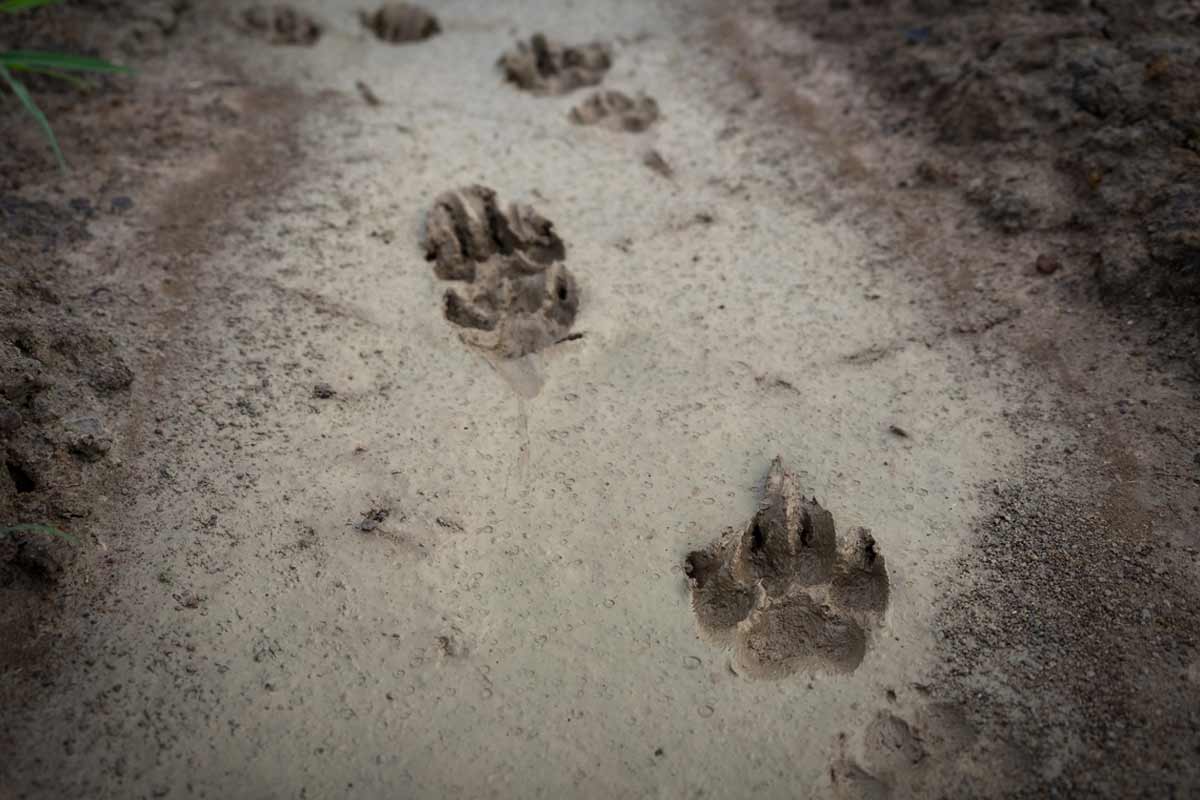
For some, spotting animal tracks may pose a fun mystery to solve. For others it may be a startling experience that rapidly turns frightening. How you react can be a direct result of your ability to identify these paw prints. A positive identification can put you at ease, or the unknown can bring on a sudden moment of terror.
Depending on the environment around your home, any number of animals may make a path through your back, front or side yard. But how do you know if it’s a wild animal or just the neighbor’s cat? There are several factors you can look for to help identify the prints that are left behind.
Canine Tracks
Most of the time when you hear the word canine you immediately think of the family dog. But it can also refer to foxes, wolves, and coyotes. Canines have oval-shaped paws on both the front and back feet. Each paw has a heel pad and four toes, each with a claw, that are close together and point forward.
Their front and hind tracks are identical and you will see claw marks. Canines are considered diagonal walkers – which means they lift their front and hind legs on opposite sides at the same time. For this reason, their tracks are staggered.
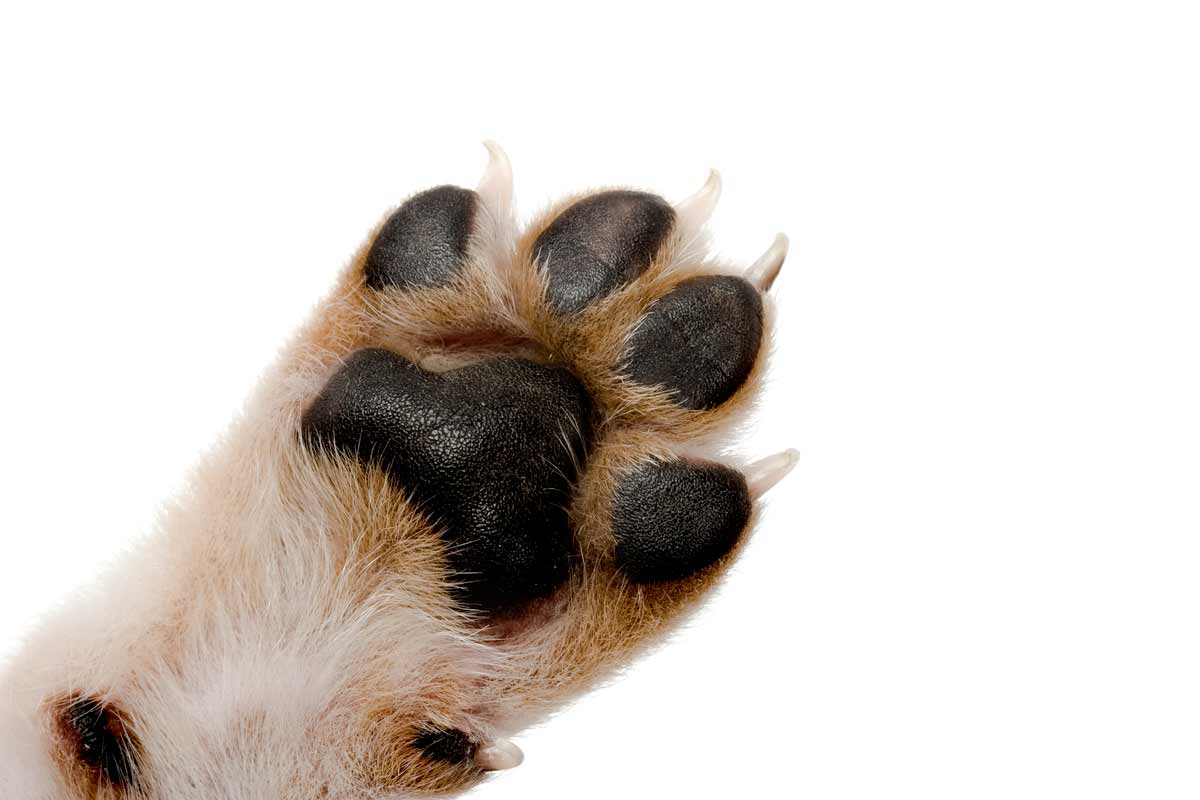
Each paw has a heel pad and four toes, each with a claw, that are close together and point forward. Their front and hind tracks are identical and you will see claw marks. Canines are considered diagonal walkers – which means they lift their front and hind legs on opposite sides at the same time. For this reason, their tracks are staggered.
Wolf Tracks
They have four symmetrical toes on their front and back feet, and the front track will be a little bit longer and wider than the back.

Wolves
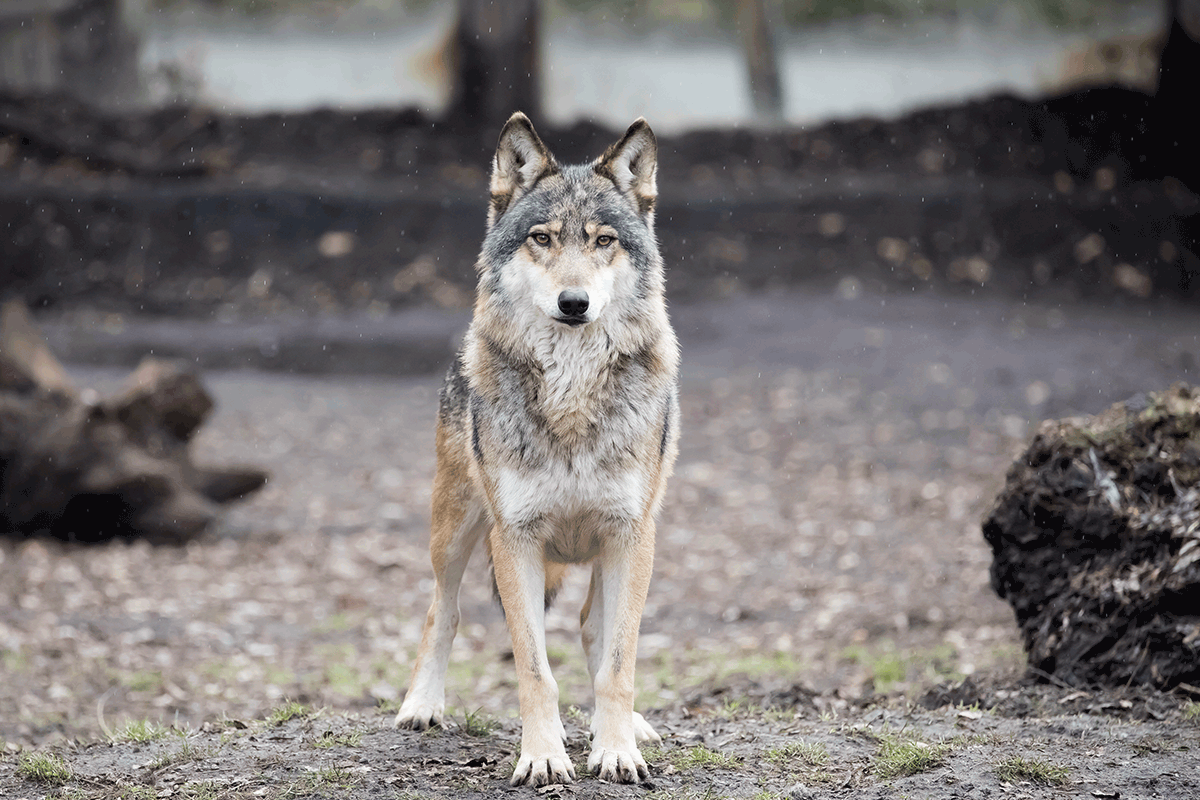
Geography
Wolves have been hunted for decades, so they aren’t as plentiful as they once were. But they can be found in the Great Lakes, the northern Rockies, and the Southwestern United States. These animals live and travel in packs, so if you see one print, there are likely to be more in the same area.
Factor to Identify
A wolf is the most massive canine with the biggest paw. The print measures about four inches long. They have four symmetrical toes on their front and back feet, and the front track will be a little bit longer and wider than the back. Because they are a relatively large canine, the toes in their tracks will also be more spread out compared to other canine tracks. Wolves also rely on their stealth, and are often cautious while they’re traveling. Another way to identify wolf tracks in comparison to other canines is that they tend to walk in a straight line, while dogs walk in a more erratic pattern.
What to Do if Tracks Are Found
If you see wolf tracks in your yard, they’re likely passing through on the way to hunt or find shelter. However, if you do see if a wolf in your yard, stay calm. Wolves aren’t used to people, and will likely run away if they see you. If you see a wolf and it doesn’t seem afraid, it could either be sick or more accustomed to seeing people.
When to Call a Professional
If you can, look at the wolf from afar and evaluate it for signs of disease. Rabies will manifest in canines through aggression, usually with excessive salivating or foaming at the mouth, or they could also show signs of paralysis. Even if you see a wolf on your property that doesn’t seem aggressive, it’s best to call wildlife removal to have the animal safely removed. Whether they’re diseased or not, it’s best for them to avoid your property as a potential new home.
Coyote Tracks
A coyote’s print measures between two and a half to three and a half inches long and it’s more narrow than that of a wolf.

Coyotes
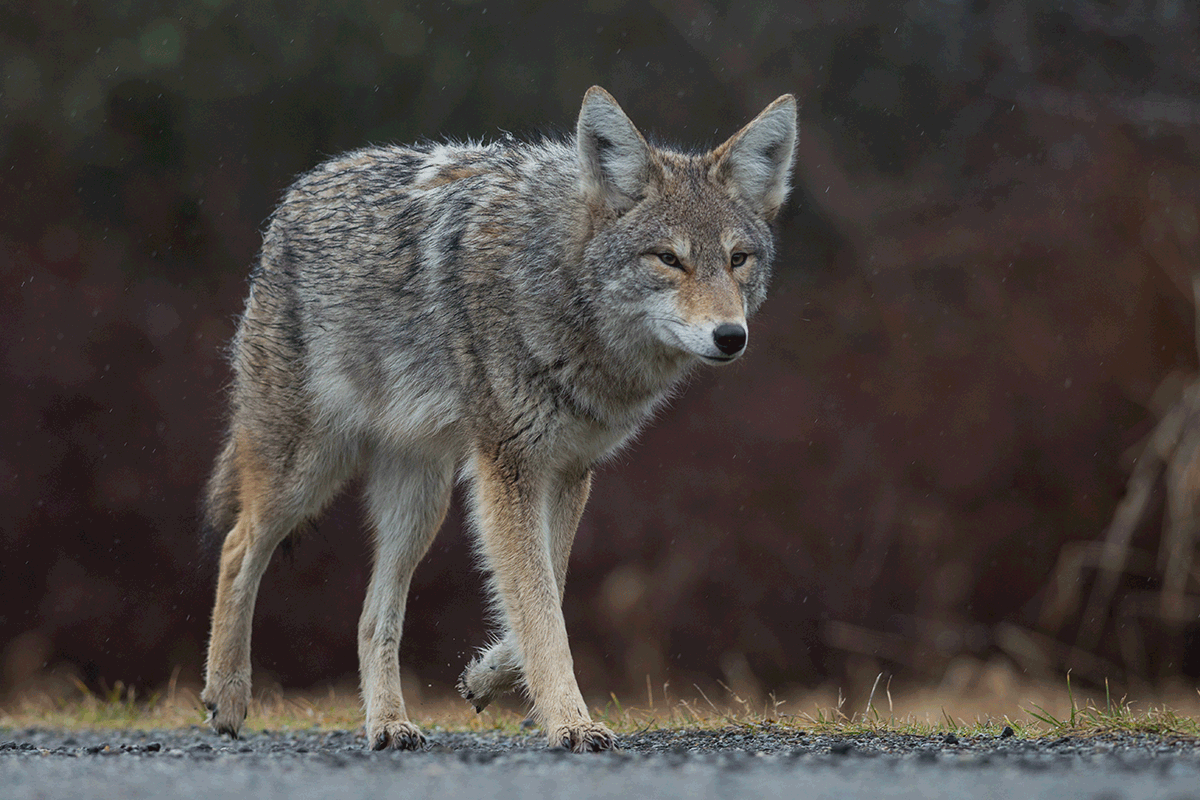
Geography
Coyotes can be found close to anywhere in the United States – deserts, swamps, forests, mountains, and even the suburbs and cities. They’re scavengers searching for food, and they’ll go wherever they need to find it.
Factors to Identify
A coyote’s print measures between two and a half to three and a half inches long and it’s more narrow than that of a wolf. The front tracks are bigger than the hind ones, and the foot pads will be smaller on the back feet. Because coyotes are small, their prints are often mistaken for dogs, but coyote’s prints are oval-shaped and more elongated than a dog’s print. The space between a coyote’s footpad and toes will also be much wider than that of a dog.
Like wolves, coyotes tend to live in packs, though when they travel or hunt they’ll usually be alone or in a single pair. If you see solitary tracks with the characteristics we’ve outlined above, it is likely a coyote instead of a wolf or a dog.
When to Call a Professional
Like wolves, if you see a coyote in your yard you should try to monitor for any signs of aggression, and call wildlife removal if they seem diseased or won’t leave your property. Especially if you own pets, coyotes have been known to attack dogs and cats, so they should be removed safely as soon as possible.
Fox Tracks
Fox footprints are usually oval-shaped as a whole, and their four toes typically have a triangular shape.

Foxes
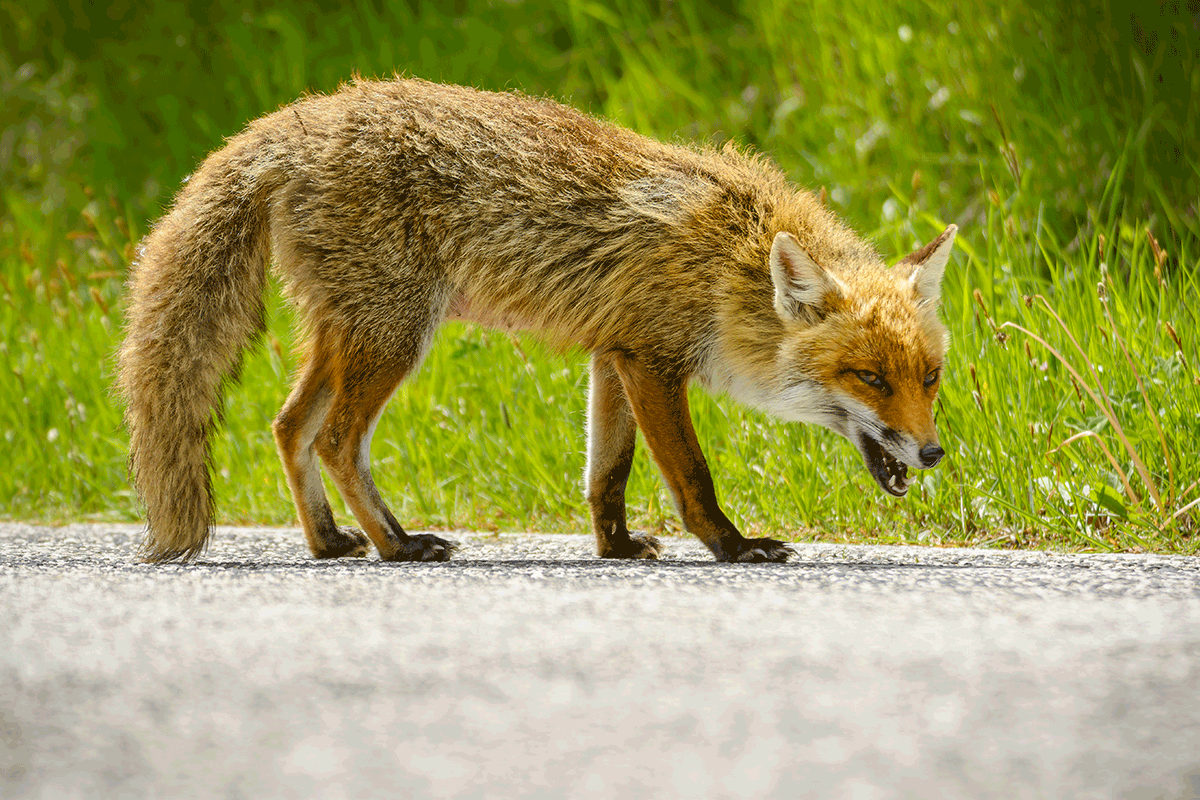
Geography
You can find foxes in every state in the U.S. except for Florida. Foxes have the smallest print in the canine group measuring at two to three inches long. Fox prints have a couple of distinguishing characteristics. They have more hair in their paws, so their print is fuzzy around the edges, and they also tend to drag their feet.
Factors to Identify
Fox footprints are usually oval-shaped as a whole, and their four toes typically have a triangular shape. The foot pad of the red fox has a distinct chevron-shape. They commonly walk in a direct register trot, which means their back foot lands right on top of where the front foot has been.
DIY Solutions
Foxes are omnivores that will eat both animals and vegetation, but they generally eat more plant life in the spring and summer. If you have a lot of fruiting trees or berry bushes on your property, you should take proper precautions to exclude foxes and other pests, such as putting up fencing.
Dog Tracks
One difference can be determined in how the animals walk. Wolves and coyotes conserve their energy and walk in a straight line. A dog makes zig-zags and circles as it walks.

Dogs
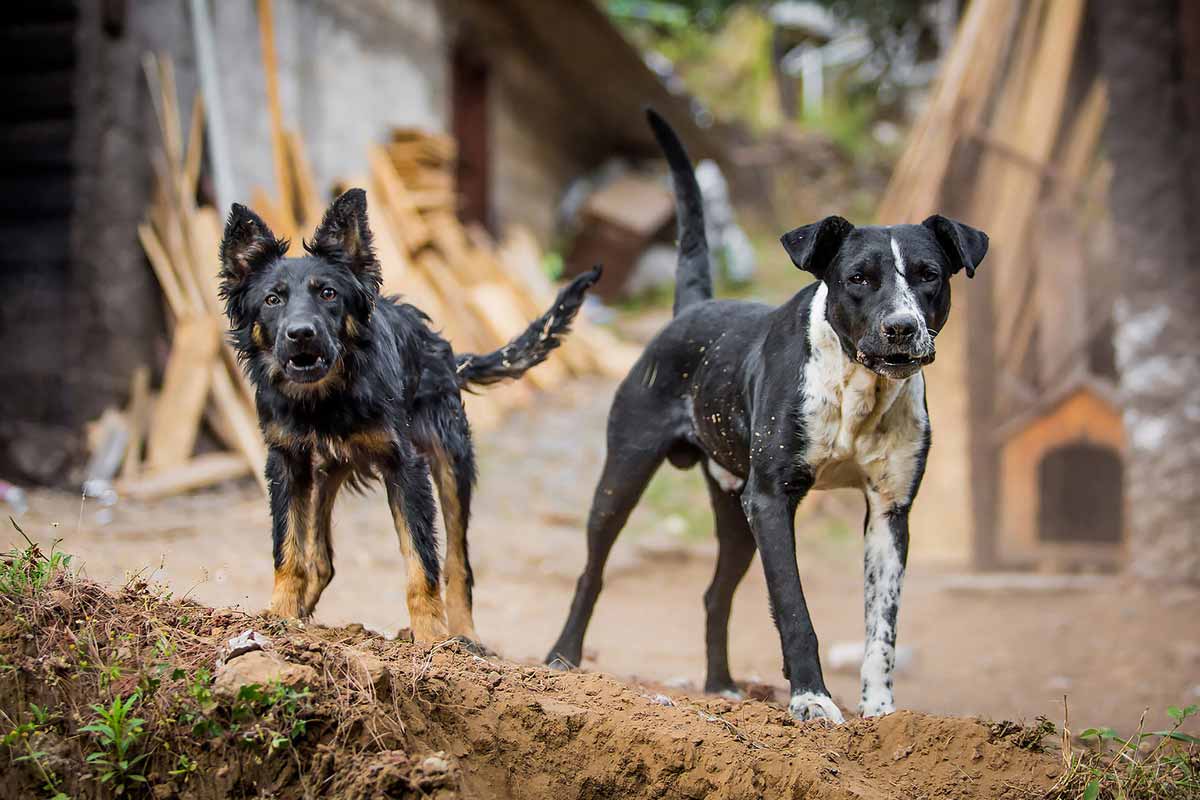
Factors to Identify
Wolf, coyote and dog prints can be difficult to tell apart since they are all similar in size. One difference can be determined in how the animals walk. Wolves and coyotes conserve their energy and walk in a straight line. A dog makes zig-zags and circles as it walks. You will also see a difference in the nails. Wolves and coyotes will leave thin, sharp nail prints behind. A dog’s nails are thicker and blunter. Domesticated dogs also produce tracks where their toes and nails are pointed outward because they tend to splay their toes.
DIY Solutions
Dogs are common everywhere throughout the U.S., and if you see one in your yard it likely isn’t a threat. However, stray dogs can easily contract diseases like rabies, and you should take the proper precautions before approaching one, just like you would with a wolf, coyote or fox. If a dog on your property doesn’t seem like a threat, there usually isn’t a need to call wildlife removal. If the dog will let you approach it, you can try to see if it has a collar or any other identification. If not, you can call animal control, which will be able to pick up the dog, treat it, and try to get it ready for adoption.
Felines
Just like the canine family includes more than just dogs, the feline family is more than just house cats. Bobcats, cougars, lynxes and mountain lions are all felines and have paws with four toes. Their toes have claws, but you won’t see them in the print because they retract their claws when they walk. Feline paws are round in shape and are as wide as they are long.
Their front and back tracks are identical, and much like canines they are diagonal walkers. They leave behind staggered tracks because they lift their front and back legs on opposite sides simultaneously.
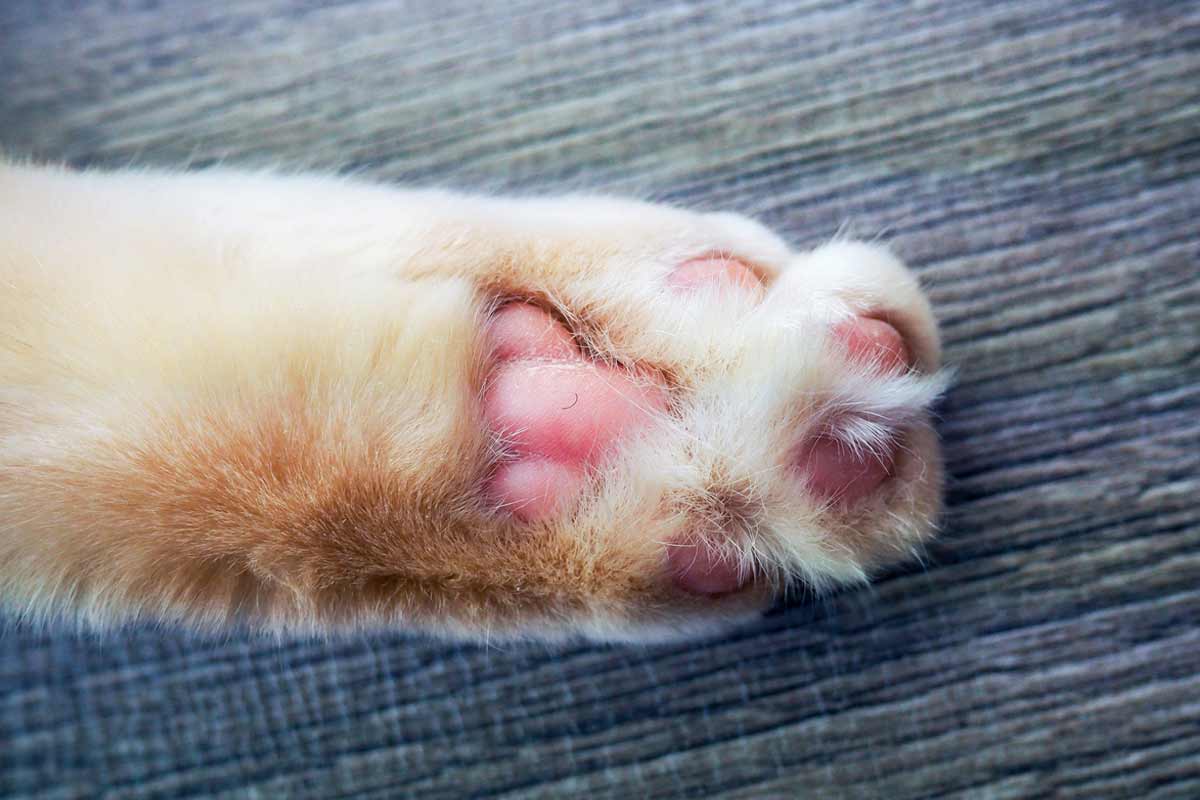
Mountain Lion Tracks
Mountain lion tracks are usually bigger than three inches long and just as wide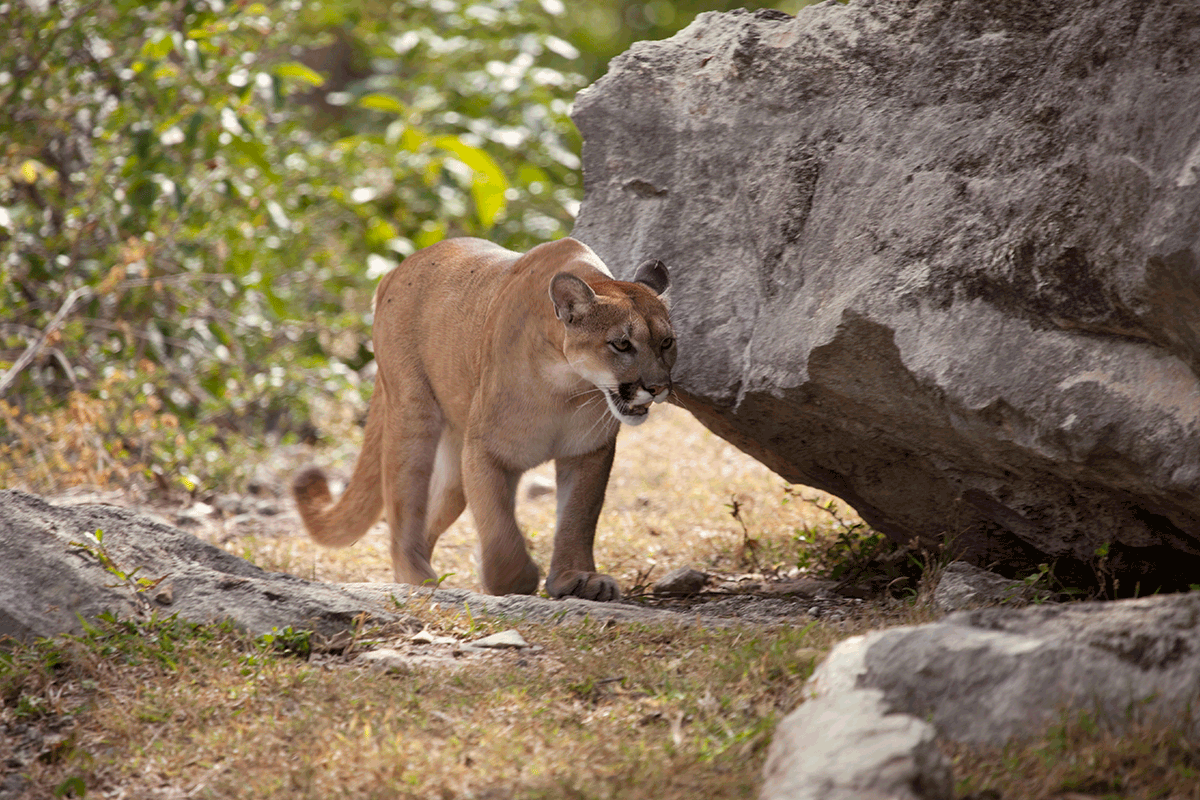
Cougar or Mountain Lion

Geography
Whether you call it a cougar or a mountain lion, they’re one in the same. It can be found roaming from the U.S. Canadian border, south to California and Texas. Some small populations have also started to make their way east of the Mississippi River.
Factors to Identify
The mountain lion has the largest tracks of any feline in the United States. The prints are usually bigger than three inches long and just as wide. The track is asymmetrical and will show four round toes. The front track will be broader than the back.
Cougars are rarely seen in residential areas for multiple reasons. Many of their populations have been reduced due to hunting and habitat loss, and they also tend to remain stealthy and isolated when traveling and hunting.
DIY Solutions
If you do come close to a cougar, it’s best to leave it be and give it as much space as possible, and you can also scare it away by making loud noises like whistling or yelling. Whatever you do, you shouldn’t run away as the cougar will then think of you as its prey.
To prevent cougars from coming onto your property, reduce the amount of food that they could access. Take the necessary time to fence your vegetation, and never leave any food outdoors.
Lynx Tracks
The lynx typically walks in an alternating pattern and also tends to meander.

Lynx
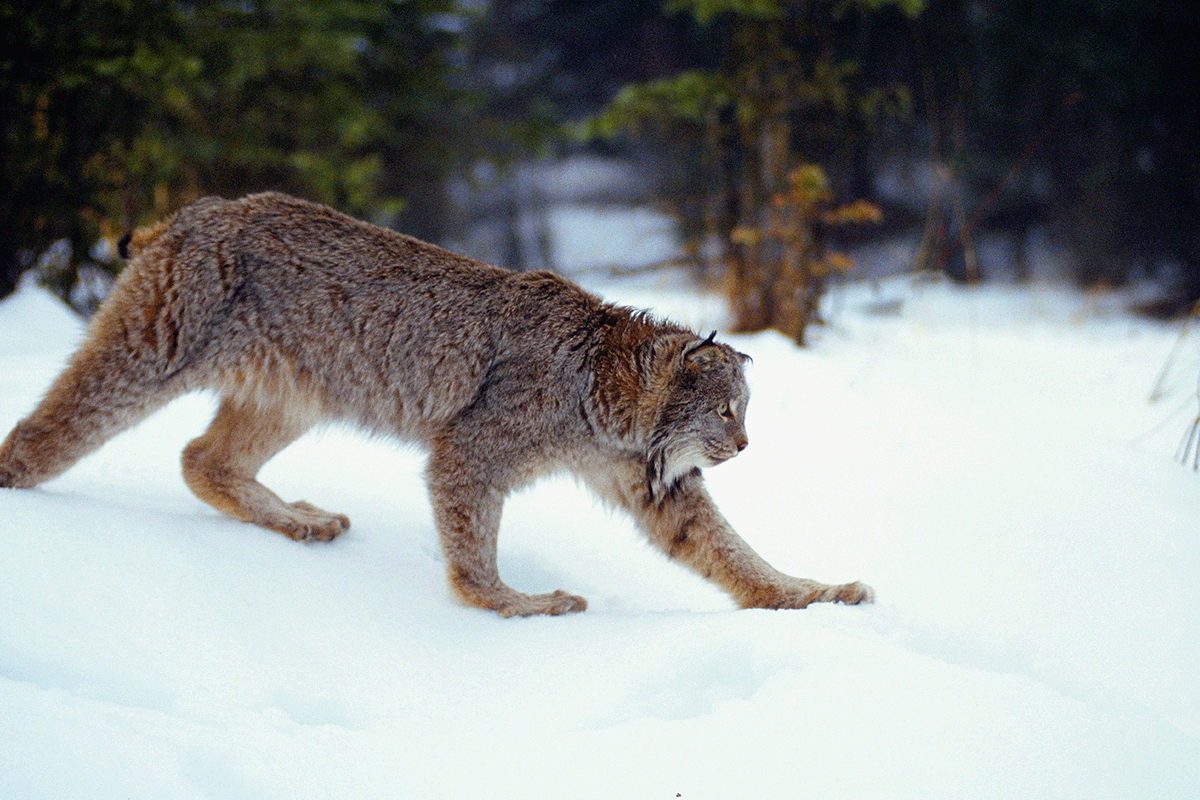
Geography
The lynx can be found in parts of California, Colorado, Idaho, Maine, Michigan, Minnesota, Montana, New Hampshire, New York, Oregon, Utah, Vermont, Washington, Wisconsin, and Wyoming. They are an endangered animal, so finding their tracks is often a rare occurrence.
Their main habitat is in cold, snowy forests, so if you do see their tracks it will likely be in the snow.
Factors to Identify
The print will be about the same size as the mountain lion or cougar, but it will look different because they have so much fur around the sides of their paws that it obscures the foot pads. The lynx typically walks in an alternating pattern and also tends to meander.
Lynx are solitary felines, so their tracks will be found alone, and there won’t be signs of a pack. They’re also more active at night and aren’t habituated to humans, so it’s very unlikely that you will come across a Lynx.
What to Do if Tracks Are Found
If you do identify lynx tracks, you should begin monitoring the area to see if more appear. More likely than not, the lynx was just passing through and won’t make a home on your property.
Bobcat Tracks
Bobcat tracks are usually around two inches long and don’t have a nail imprint.

Bobcat
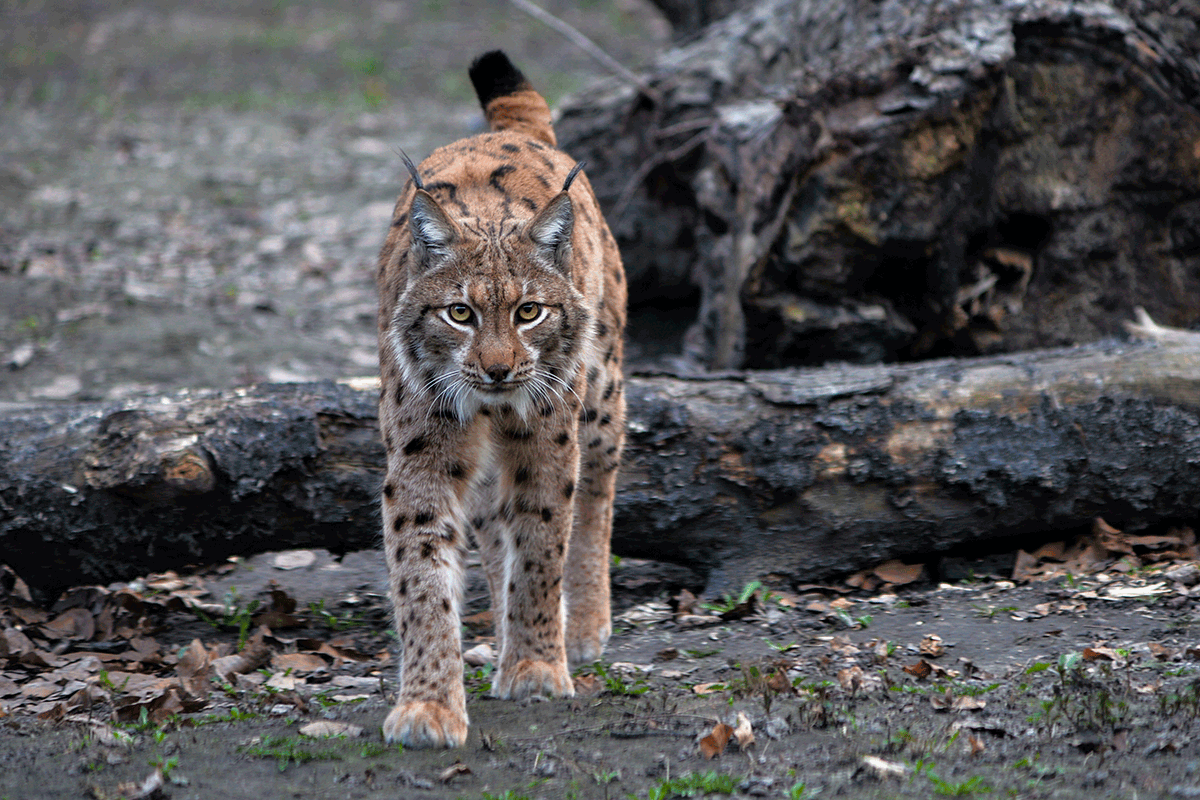
Geography
Bobcats are found all across the United States of America and tend to make a home in a variety of different habitats, including deserts, forests, and suburban areas. Bobcat tracks in snow are usually the easiest to identify, and they’re usually more active and hunting more animals in the winter time.
Factors to Identify
Their tracks are usually around two inches long and are sometimes confused with the fox or coyote. The most important difference is the lack of a nail imprint in a bobcat track. The animal tends to walk in an alternating pattern and roam instead of moving in a straight line.
What to Do if Tracks Are Found
Bobcats are solitary animals, so it’s unlikely that you’ll find a pack of tracks. If you do happen to see a pair of tracks, you probably don’t need to take any action. Though bobcats are known to appear in suburban areas at times, they hunt animals that are often pests, like mice, other rodents, and birds.
For the mothers to raise their litter, they choose secluded dens as their home. This makes it unlikely that they’ll become a presence on your property, unless you might live near a forest.
House Cat Tracks
Cat tracks are small – usually between one and one and a half inches – and tend to show wandering.

House Cat

Geography
House cats are found all over the united states, and there are many strays and wild cats that are likely to leave tracks on your property.
Factors to Identify
House cat prints are small – usually between one and one and a half inches. Unlike other felines, house cats don’t walk in a straight line; they tend to wander around.
What to do if Tracks Are Found
If you see very small feline tracks around your home, there’s no cause to worry. Cats are a great help for getting rid of pests, and can help eliminate birds and rodents around your home.
When to Call a Professional
If you see a house cat roaming around outside that looks unkempt, it’s probably a stray. Cats can fend just fine on their own, but you can also check for a collar or other identification to see if it has an owner to return to. If it does seem like an unhealthy stray, you can call animal control to have the cat picked up. Professionals will be able to take the cat in and determine if it can be helped or adopted. Note that animal control is the best solution if you find a dog or cat around your property, but you should opt for wildlife removal if you’re dealing with a much bigger feline or canine, or if you come in contact with any animal that seems diseased.
Rodents
Rodents are a class of animals that includes mice, rats, squirrels, porcupines, and beavers. The size and shape of rodents vary greatly, but they all have front feet with four toes and back feet with five toes. And the tracks will indicate that. The front tracks will also be smaller than the hind ones. Rodents tend to hop, jump or gallop so the front and hind tracks are close together with large spaces between sets.
Beaver Tracks
Their front feet are between two and a half and three and a half inches long. Their back feet are webbed and between four and a half and seven inches long.

Beaver
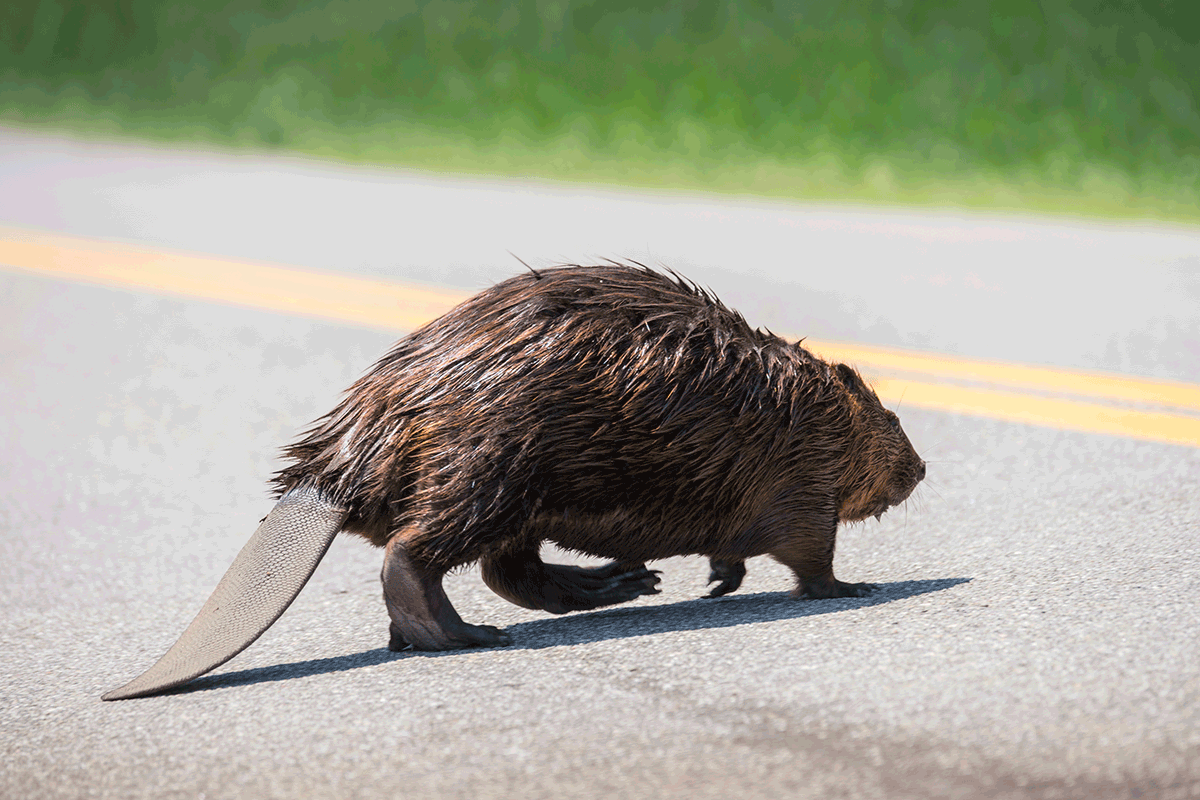
Geography
If you live near a body of water, then it may be easy to determine if a beaver is the animal roaming around. You may find tracks, but you’re more likely to determine it’s a beaver because of dams they have built or nearby trees they have gnawed. Beavers are found in most of the U.S. except for southern California, Florida, Nevada, and parts of Alaska.
Factors to Identify
Their front feet are between two and a half and three and a half inches long. Their back feet are webbed and between four and a half and seven inches long. Beavers waddle when they walk and often wipe out their front print with their back foot. Or they may wipe out both their front and hind print from dragging their large tail against the ground. If you do see a front print, it will likely resemble the size and shape of a small human hand, though with longer “fingers” and less space in between.
What to do if Tracks Are Found
If you see beaver tracks, it likely isn’t cause for concern. Beavers will keep to themselves and aren’t usually found to bother people. However, if you live near a body of water, their eating habits and dams could cause damage to the land around in the form of crop loss, flooding, and more.
If you find beaver tracks, it’s best to leave them be and search for additional signs of beavers, such as their dams and damage to nearby vegetation. They’ll cut down large trees for their habitats and feed on vegetation such as grasses, ferns, and crops like corn.
When to Call Wildlife Removal
If it looks like there are beavers around your home causing damage, you should leave everything as it is and call wildlife removal to help implement exclusion practices. Trained professionals can help coax the beavers away from your property or remove them safely, and they may use any tracks that are there to help track where they’ve setup their habitat.
Porcupine Tracks
Porcupines are pigeon-toed, so their tracks point inward. They have relatively small feet, so the tracks you find will only be between one and two inches long.

Porcupine
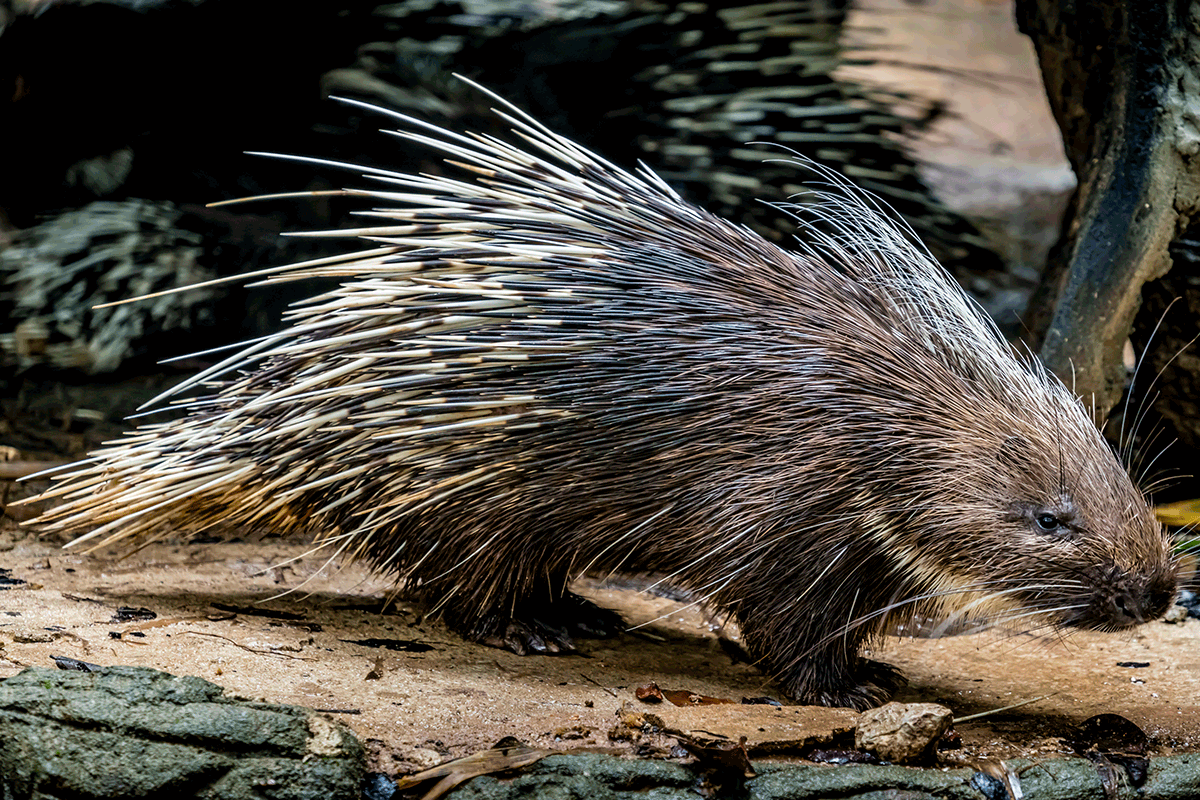
Geography
Porcupines are found all over the western part of the U.S., but only in Michigan, New York, Pennsylvania, Wisconsin and the New England states on the eastern side of the country.
Factors to Identify
Like beavers, porcupines waddle when they walk. They have long toes with claws to climb trees, but they move slowly. Porcupines are pigeon-toed, so their tracks point inward. They have relatively small feet, so the tracks you find will only be between one and two inches long. Because they’re climbers, they have big heel pads with a rough surface that you may be able to see in the track. You may also see the imprint of the tail alongside the track where the animal has dragged it on the ground.
What to do if Tracks Are Found
Porcupines will likely steer clear of humans, so if you identify their tracks it isn’t likely that there will be one nearby, or if so it will be hiding. If you do see porcupine tracks, look around for other signs of the animal. They eat the bark off of trees and vegetation, and they also like to dig up root vegetables, so those could point to signs of a porcupine on your property.
If you do come face to face with a porcupine, don’t get too close. It won’t try to attack you, but if you manage to come in contact, its quills can cause serious harm.
When to Call Wildlife Control
Porcupines can cause damage to your garden, lawn, and even your home if they get close enough. Though they aren’t an active threat, it can be imperative to remove them from your property, especially if you own outdoor pets that might come in contact and harm themselves. If you see signs of porcupines beyond just their tracks, it’s a good idea to call wildlife control so a professional can come inspect your property.
Mice and Rat Tracks
They have small feet – the front is less than a half inch long, and it has four toes. The back feet are less than one inch long and have five toes.

Mice and Rats
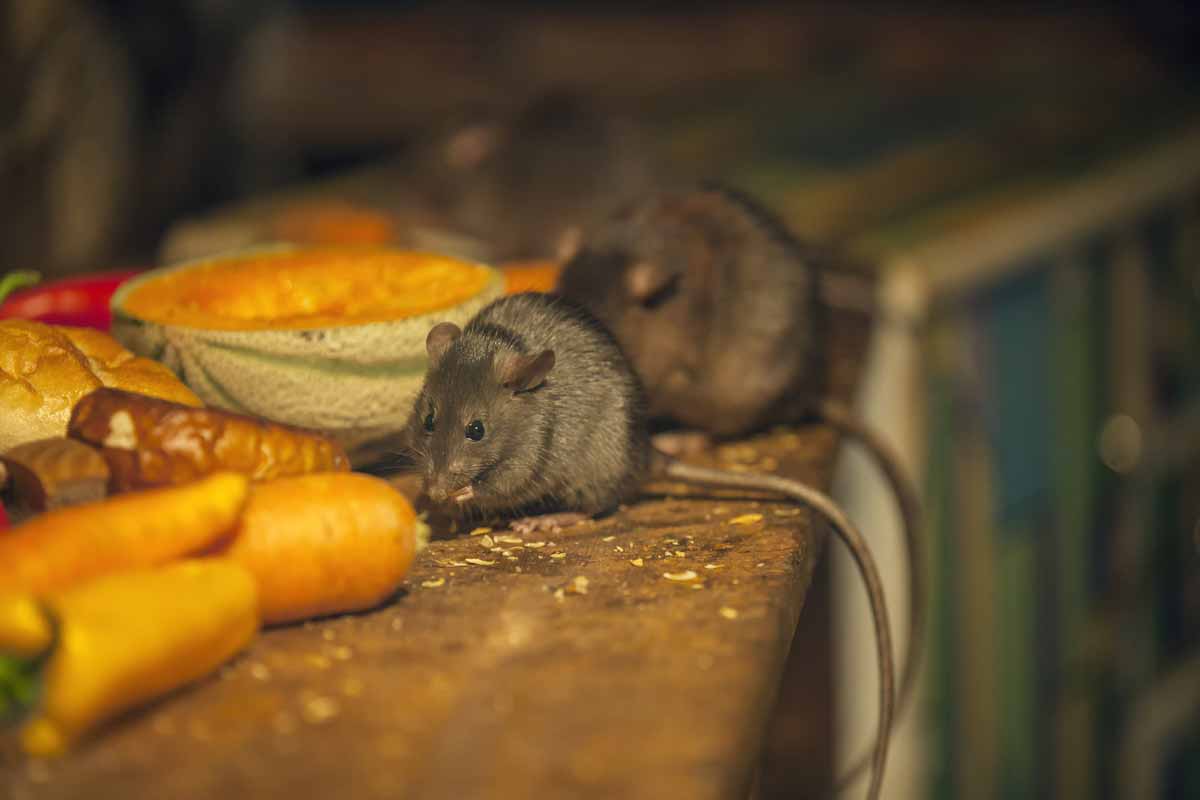
Geography
If you live in Northern states, you’ll be more likely to see mice than those living in Southern states. However, mice are likely to appear in homes across the entire U.S. once the temperatures begin to drop, since they’re mammals just like us searching for warmer temperatures.
Factors to Identify
Simply put, mice are everywhere. It seems there isn’t a corner of the world where you won’t find a mouse. They have small feet – the front is less than a half inch long, and it has four toes. The back feet are less than one inch long and have five toes. Mice hop to get around, so their front and back prints will often be side by side.
If you see what looks like mice tracks, another good identifier will be their droppings. Mice droppings are small (smaller than rats), and measure about a quarter inch or shorter.
Rats, like mice, are all over the place. They also have small front feet with four toes and larger back feet with five toes. On the back foot, the middle three toes will be closely grouped and facing straight, with the two outer toes facing outward.
As they travel, the hind feet will often land on the place where the front feet were, erasing the front print. One unique characteristic is that rats have six pads on each foot that will usually show up on the track.
Squirrel Tracks
Squirrels like to hop, and their tracks usually meander, instead of following a straight path.

Squirrels
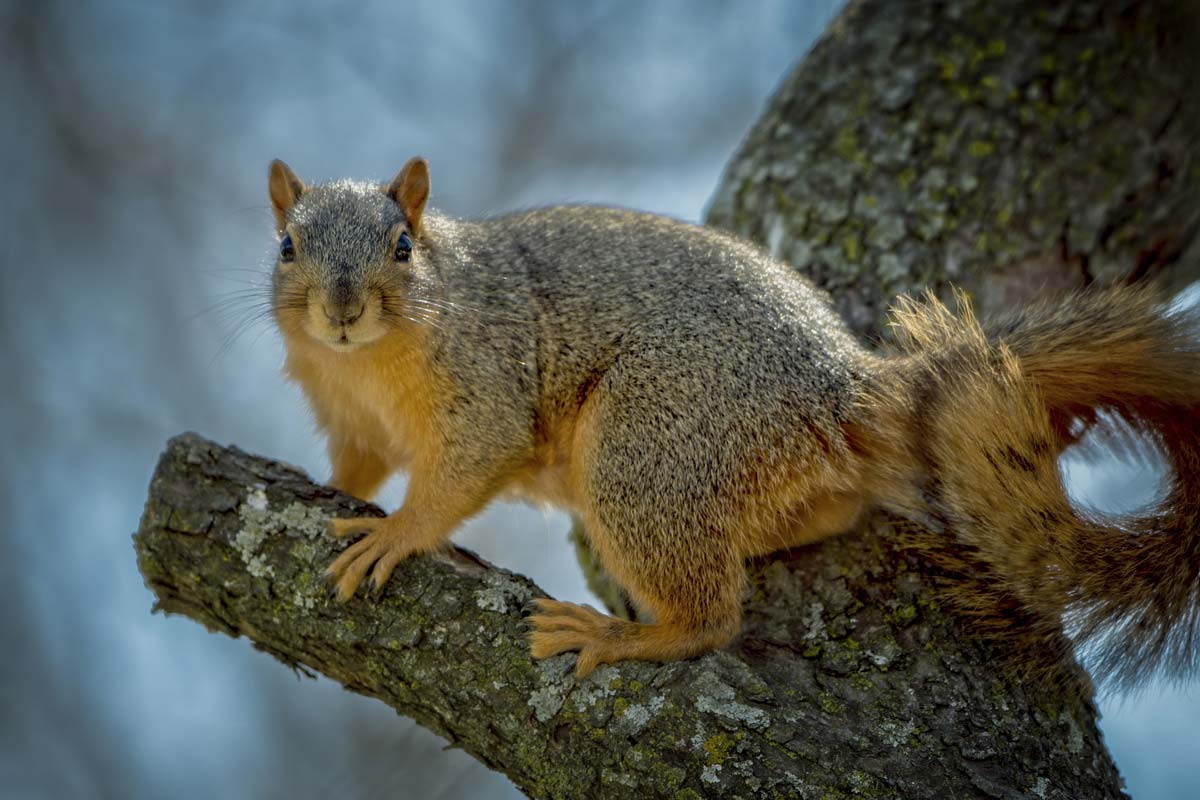
Geography
Squirrels are another animal that can be found everywhere. You’ll usually find them climbing quickly through your trees or searching for nuts throughout your lawn. Their front feet measure about an inch to an inch and a half long, while the back feet measure one and a half inches to two inches long.
Squirrels like to hop, and their tracks usually meander, instead of following a straight path. Their feet often land side by side, so you’ll find four distinct prints in a row.
When to DIY vs. Call a Professional
If you have squirrels on your property, they likely aren’t a threat. However, squirrels scavenge for food and run quickly across trees, lamp posts, and roofs. If you’ve found tracks as well as damage to your home, you may be dealing with a squirrel problem that needs to be handled professionally.
Otherwise, you can get rid of squirrels yourself through exclusion practices such as fencing your garden or getting rid of the trees and shrubs that squirrels are attracted to.
Other Common Animals
Hoof Tracks
The hooves are split with two toes – some toes curve and form a heart-shape, others are round and leave a round or square-shaped print behind.

Deer, Moose, and Elk
No longer are hooved animal tracks found primarily in wooded areas. As more forests become neighborhoods, more of these types of animals are showing up in backyards. Deer, moose, and elk all have hooves that leave a distinct imprint. The hooves are split with two toes – some toes curve and form a heart-shape, others are round and leave a round or square-shaped print behind. Hooved animals leave staggered tracks because, like canines and felines, they are diagonal walkers.
Moose
You’ll find the moose in the northeastern part of the United States, as well as Alaska, North Dakota, Minnesota, Michigan, and the Rocky Mountains. Moose tracks are large, measuring between five and seven inches long. They leave a heart-shaped print because their toes curve together and form a point. Because they are such large animals, they leave distinct prints that are easy to detect.
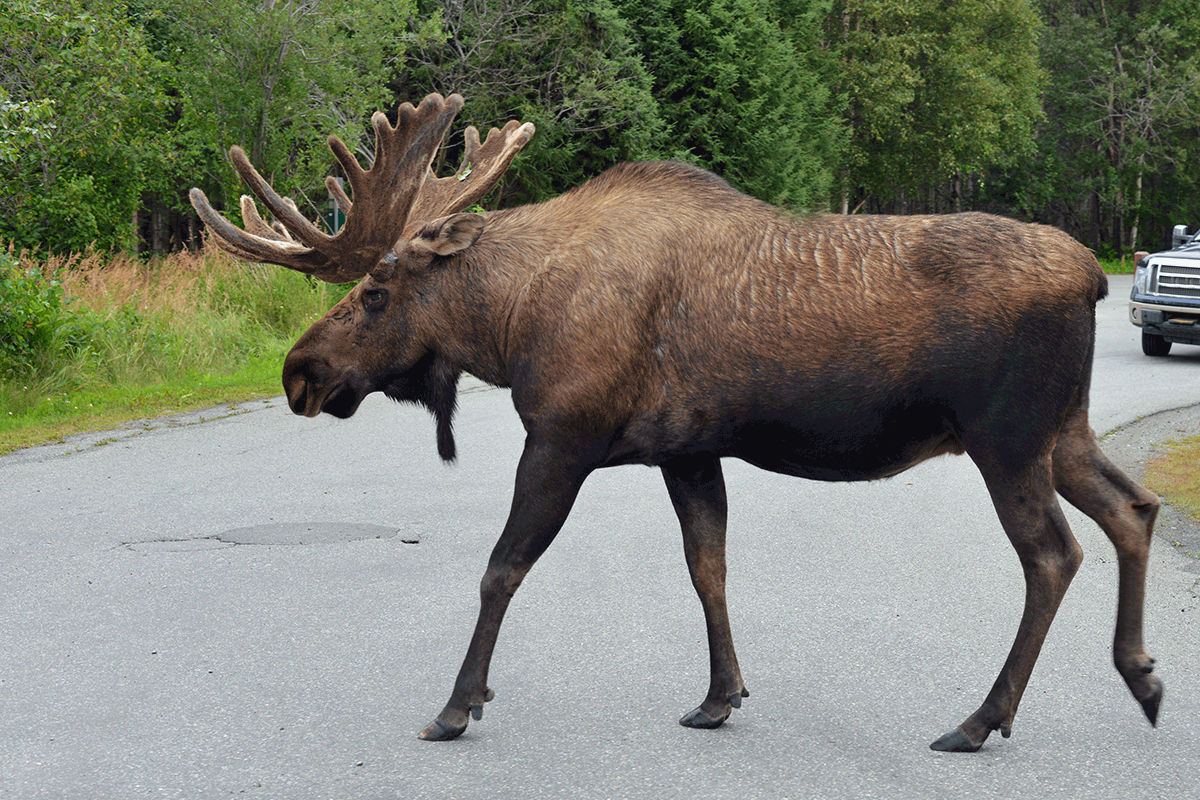
Deer
Deer are plentiful across the United States. Their prints are similar to moose tracks, but they are much smaller. They typically measure between two and three and a half inches long and are oblong in shape. Full grown deer have two hocks that extend down the leg and will make two independent dots in the ground.
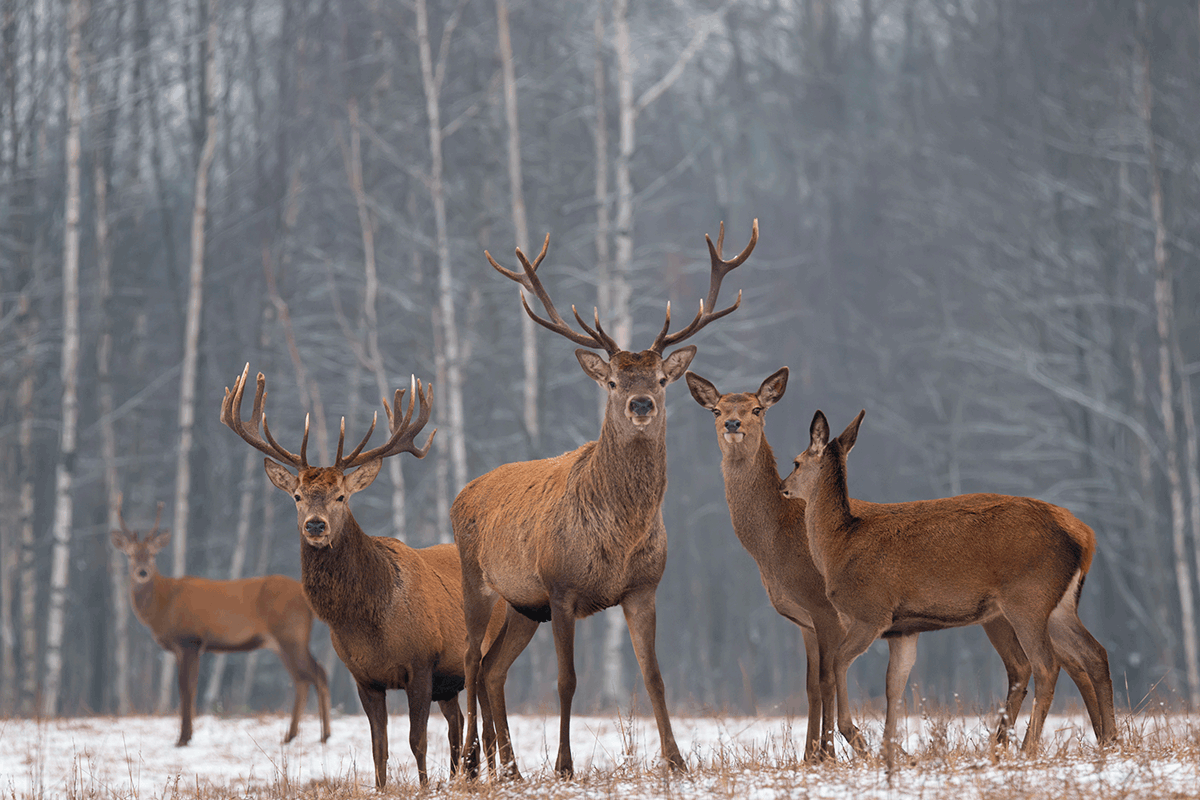
Elk
Elks are found primarily in Arizona, California, Colorado, Idaho, Montana, Nevada, New Mexico, Oregon, Utah, Washington, and Wyoming. They have more rounded toes that don’t taper as sharply at the tips as moose and deer. The prints are relatively large – between three and five inches long and are wider in the back than the front.
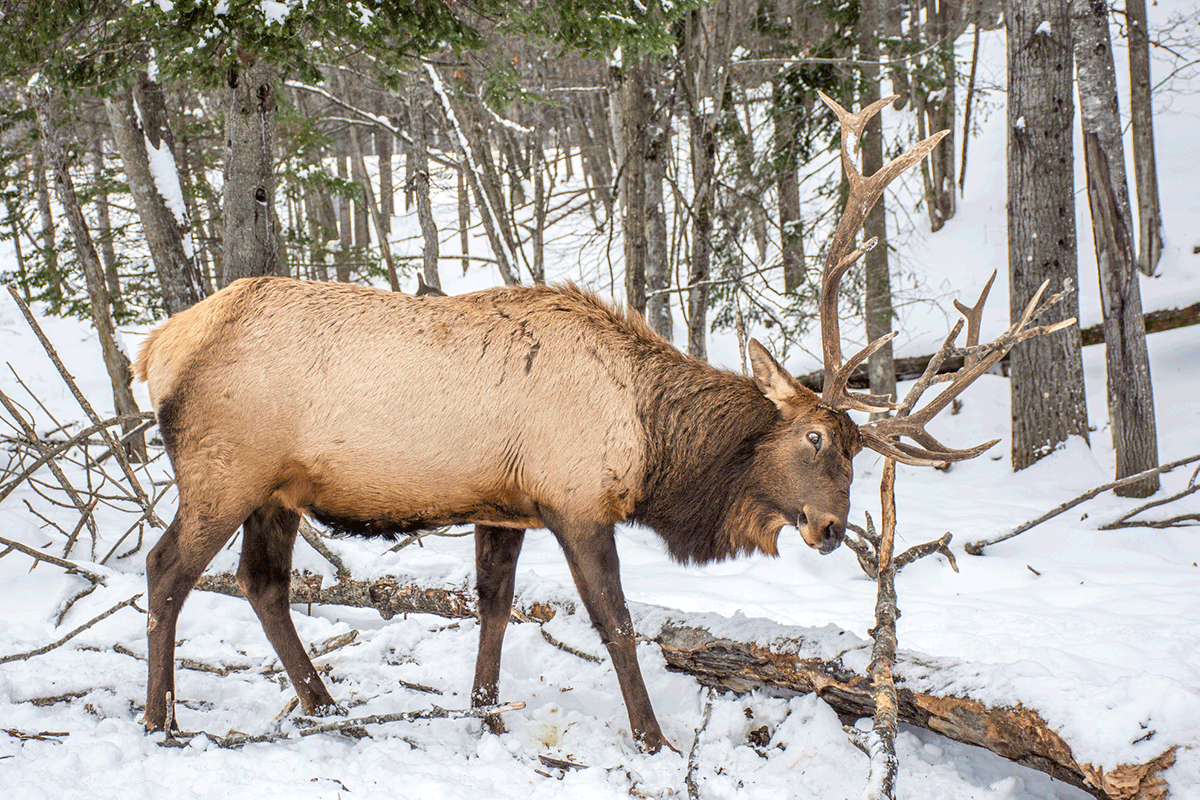
Armadillo Tracks
Armadillos have four long toes with sharp claws on the end of each. If you find an armadillo print, you’ll see what looks like the letter “V” between the middle toes.

Armadillos
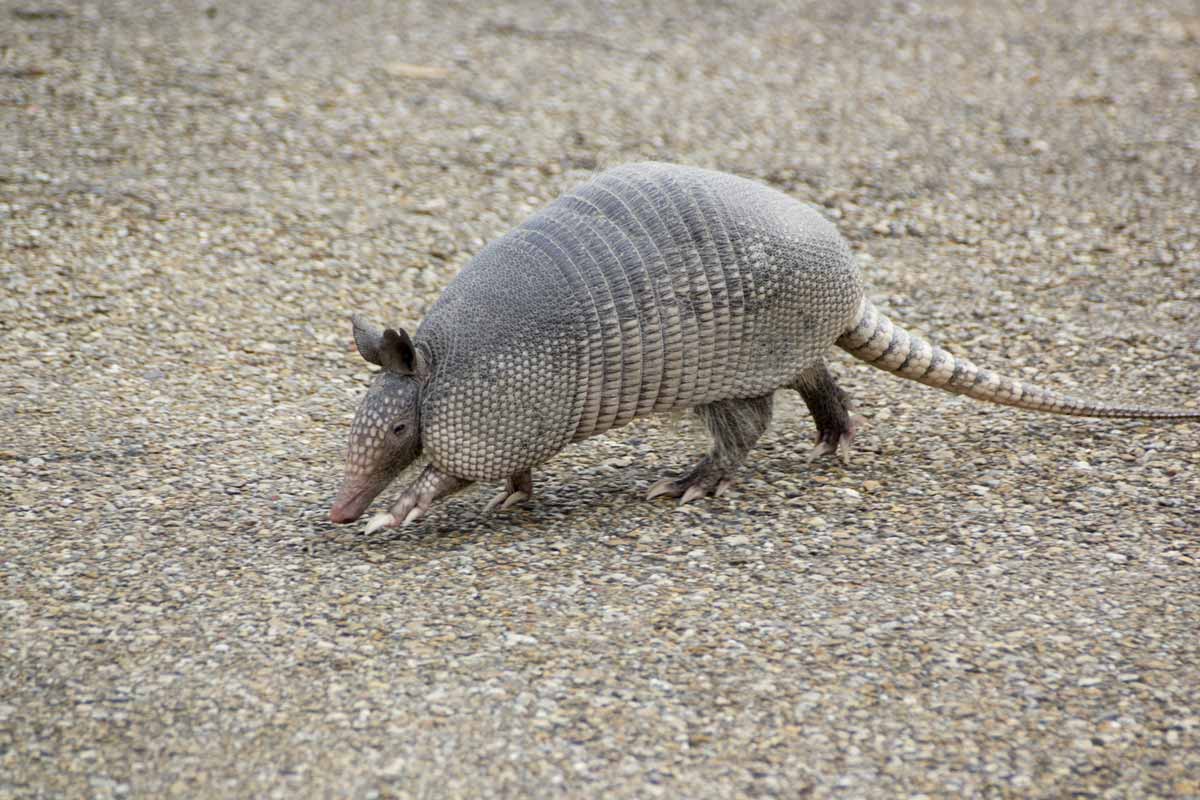
Geography
Armadillos are mostly found in the south-central United States but have migrated as far east as South Carolina and Florida and as far north as Nebraska and Indiana. But because there aren’t many natural predators that fed on the animal, they continue to move north.
Factors to Identify
Armadillos have four long toes with sharp claws on the end of each. If you find an armadillo print, you’ll see what looks like the letter “V” between the middle toes. Their toes spread out when they walk, and you will often see a line between their prints from their tail that drags the ground.
These animals are slow movers, so if you find their tracks, they may still be close by. Once they establish a home territory, they stay put, and they can cause a lot of damage. They are burrowing animals, and they can tear up your driveway, fences, yards, flower beds and the foundation of your home.
Opossum Tracks
They have five toes with claws on each foot. The rear foot has an opposable thumb, but it doesn’t have a claw.

Opossums
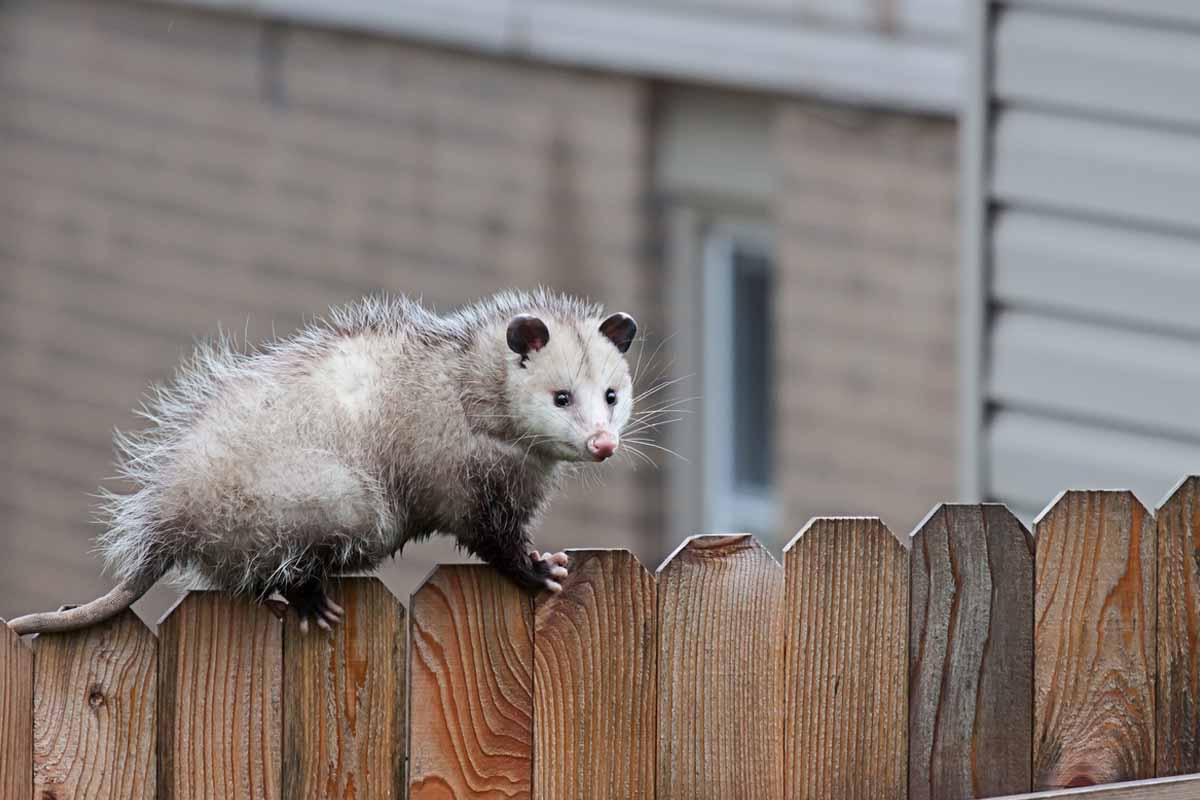
Geography
Settlers in Virginia first discovered the opossum,. Its range covers most of the United States, except for the Rockies, the western plains and the extremely cold areas of some northern states. Opossums can’t survive extreme cold.
Factors to Identify
They have five toes with claws on each foot. The rear foot has an opposable thumb, but it doesn’t have a claw. Opossums walk in an alternating pattern and sometimes, their tracks can be confused for raccoons. Look for the imprint of the opposable thumb – that will help you know the difference.
When to DIY vs. Call a Professional
Opossums aren’t known to be a threat toward humans, in fact they’re quite skittish and will even play dead if you get too close. If you find opossum tracks, they’re likely moving around your property in search of food. Getting rid of opossums is easy to DIY, since you can mitigate the amount of food and trash around your home. If there isn’t anything for them to eat, they’ll likely move on elsewhere.
Weasel Tracks
Weasels have five clawed toes on each foot, with a V-shaped footpad that will show in their tracks.

Weasels
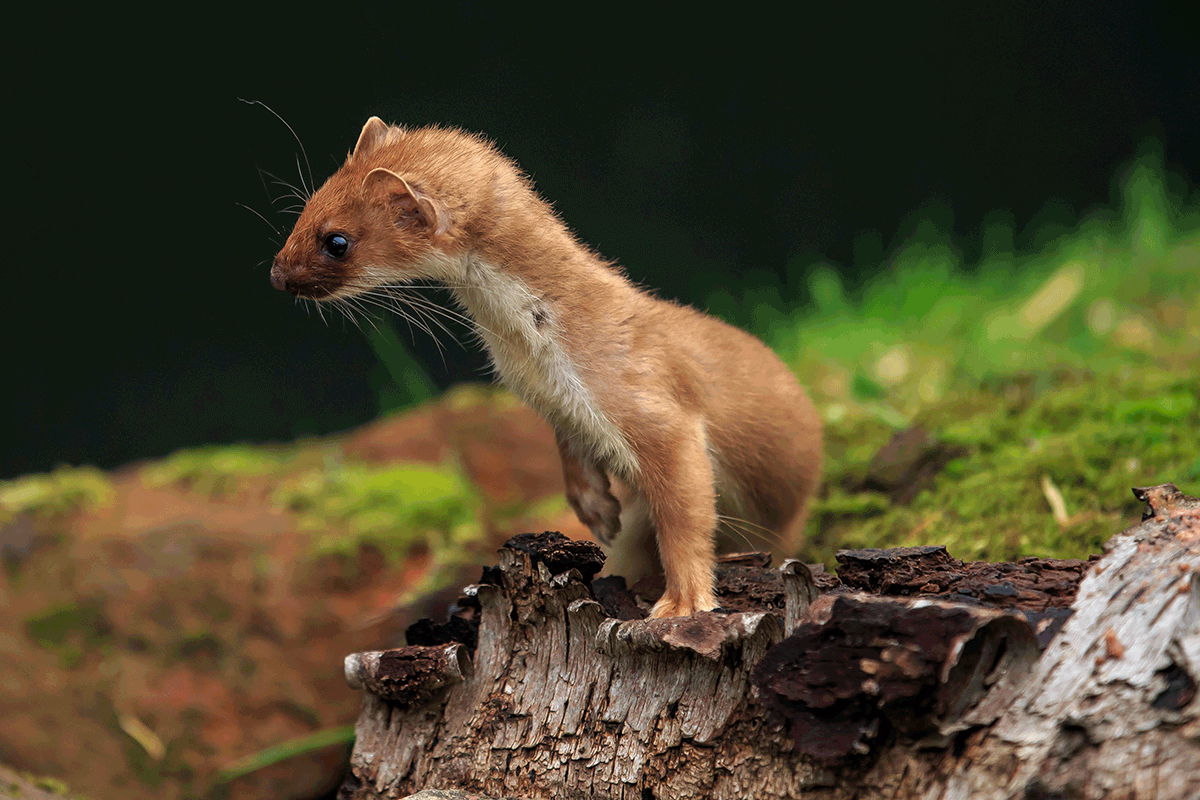
Geography
A couple species of weasels live in North America. Depending on which one, you’re likely to find them in Texas, New Mexico, Kansas and Oklahoma, or in the Northwestern states surrounding the Great Lakes. Weasels prey on smaller animals and rodents, so they’re usually found in older buildings and along roadsides.
Factors for Identification
Weasels have five clawed toes on each foot, with a V-shaped footpad that will show in their tracks. They’re also relatively small animals, so weasel tracks will be small. Another way to identify weasel tracks is if you can follow them and they tend to meander from place to place – this is a sign of a weasel searching for food and water.
Raccoon Tracks
Their front paws have five fingers which splay out from their palm. The prints left from their hind paws are similar, but their heels are longer.

Raccoons
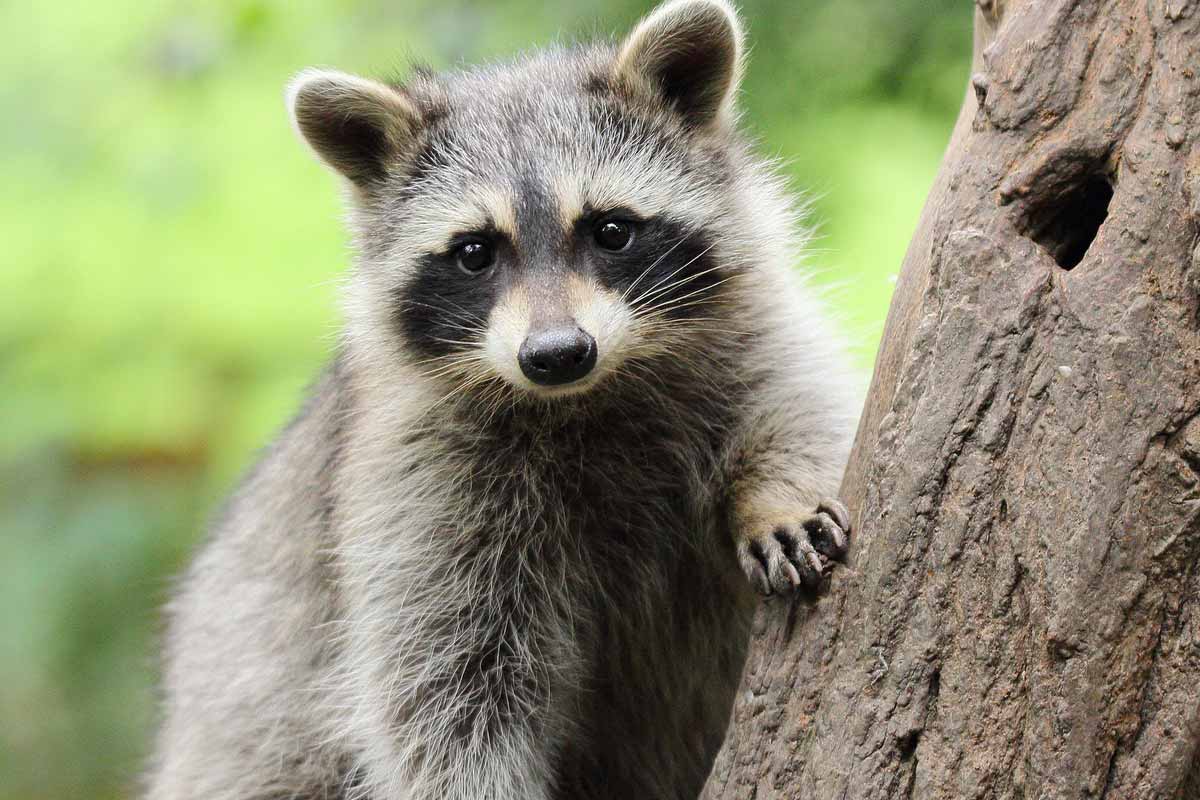
Geography
Arizona, Nevada, Utah and the Rocky Mountains are about the only places you won’t find raccoons. The animal is highly adaptable and has increased its range as forest land has decreased. They are nocturnal, so a track or the result of them rummaging through your trash can may be the only way you know they are around.
Factors to Identify
At first glance, raccoon prints can look similar to the imprint of a child’s hand. Their front paws have five fingers which splay out from their palm. The prints left from their hind paws are similar, but their heels are longer. Unlike most animals, raccoons carry most of their weight on their back feet, so the hind track sinks deeper and may be easier to spot. Because of the way they walk, their front and rear paw tracks usually end up beside each other.
Skunks Tracks
Their prints are similar to house cats, but cats retract their claws when they walk, skunks do not.

Skunks
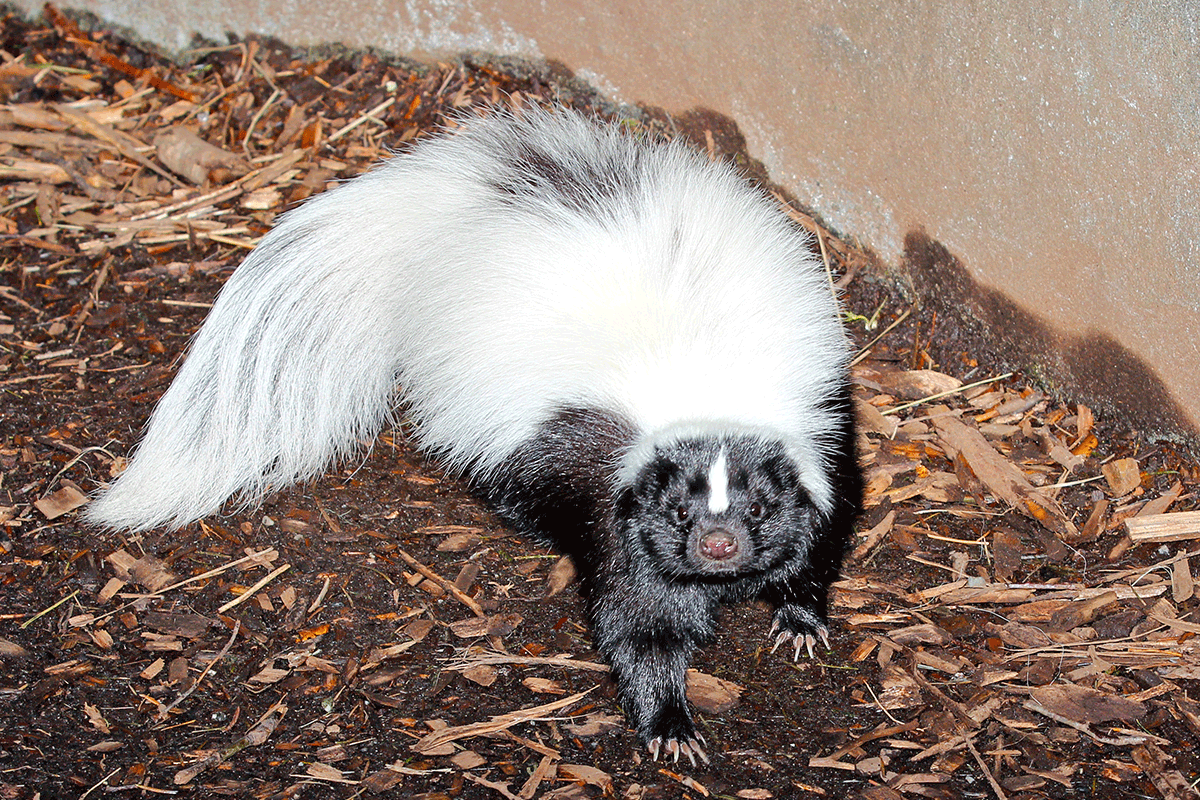
Geography
Most Americans have encountered the unmistakable scent of a skunk. These creatures can be found all across the country. They are diggers and will use their long claws to dig a new home, and that means property damage if they decide to take up residence at your place.
Factors to Identify
You’re more likely to smell a skunk before you find a track, but the prints they leave behind are as distinct as their odor. Each foot has five clawed toes. You’ll find the mark of a heel pad in the hind track that is usually between two and two and a half inches long. Their prints are similar to house cats, but cats retract their claws when they walk, skunks do not. Look for the claw imprint to determine if the tracks you’ve spotted belong to a skunk.
Mole Tracks
Their tracks are rarely seen since they spend most of their time underground. Their paws are wide and large, and each one has five long and very sharp claws.
Moles
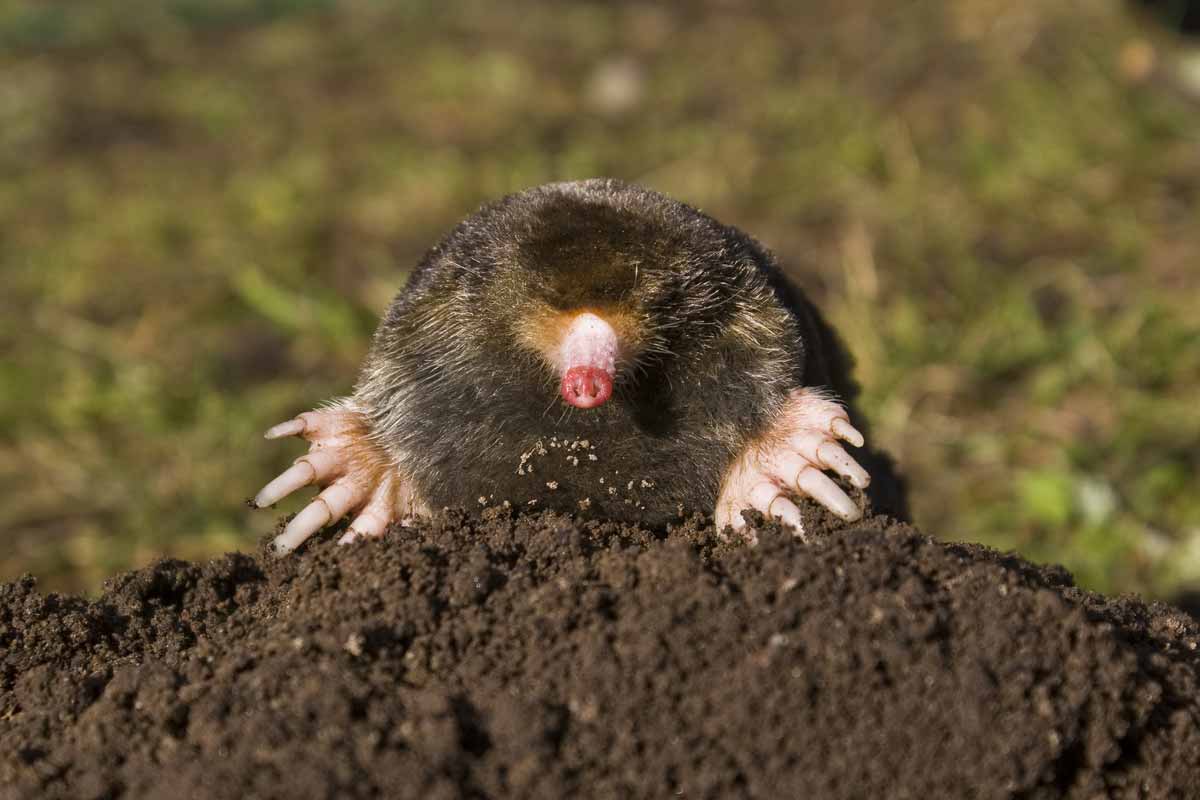
Geography
Moles have been called nature’s aerator, but that doesn’t mean you want them burrowing through your backyard. Moles are found in most of the U.S. and can cause a lot of damage as they tunnel their way through the earth.
Factors to Identify
Their tracks are rarely seen since they spend most of their time underground. Their paws are wide and large, and each one has five long and very sharp claws.
Bear Tracks
The prints they leave behind are large and are the closest animal track to human feet with five toes each.

Bears
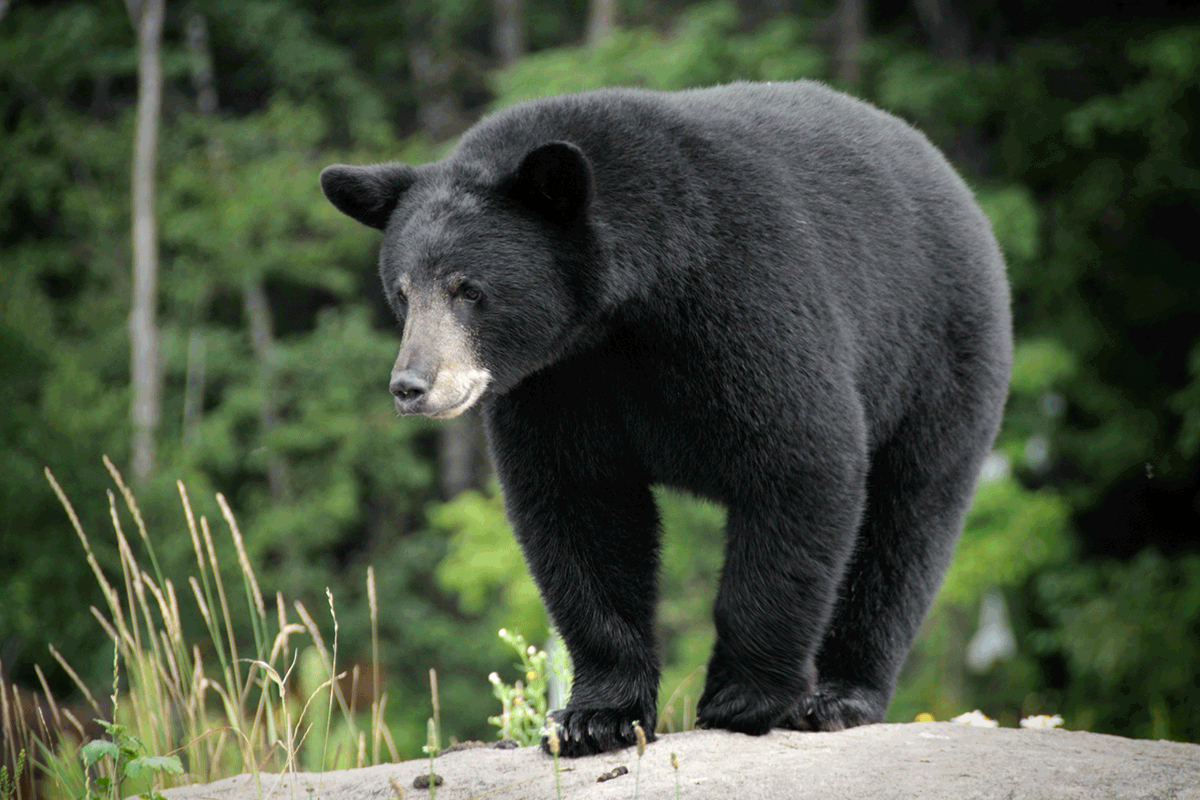
Geography
There are only three types of bears found in North America. Black bears are the most common. They live in about 40 states in the U.S. Typically they are only found in dense, wooded or mountainous areas. Grizzly or brown bears are found in Alaska, Idaho, Montana, Washington and Wyoming and most of them live in protected national parks. Polar bears are found in the coldest areas of Alaska.
Factors to Identify
Black bears are nocturnal, shy and will emerge out of their natural habitats in search of food. The prints they leave behind are large and are the closest animal track to human feet. Bears are flat-footed creatures of habit. They will often use the same trail over and over again, stepping in the same spots as they did before. Bears have five toes on each of their feet. It’s opposite the human foot with the smallest toe being on the inside and the largest toe is on the outside of the foot.
When bears walk, they put most of their weight on the outside of their foot, and their toes turn in. So, the impression will be the greatest on the outer edge. They also walk in a way where the back foot will fall just slightly in front of where the front foot landed.
What to do If Tracks Are Found
Bear tracks are relatively easy because of their size in comparison to other common animals. If you see bear tracks, don’t follow the tracks or go looking for the bear – it’s best to leave them be. Some people in Northern states have reported seeing bears come onto their property or dig through their trash. If you do see a bear that’s causing trouble, call wildlife removal instead of trying to handle it on your own.
The Best Time to Look
You may not ever truly realize animals are roaming around your backyard unless you see them, either with your own eyes or via an outdoor security camera. However, there’s another way—finding a track left behind by the animal. But to even see that, the conditions have to be right.
Rain
Snow
Sand
Sunlight
Identifying Animal Tracks
If you find a print or a track, there are some things to keep in mind that will help you identify what you’ve stumbled upon.
Get Close
Don’t be afraid to get as close as you can to the print without casting a shadow on it. The closer you can get to it, the more likely you are to be able to detect claw marks and faint impressions that will help you identify the animal.
Measure
If you’re serious about learning more about the animal, measure the length and width of the prints. Be sure to measure more than one to be sure you aren’t looking at the tracks of more than one animal. It’s not uncommon for the front feet to be bigger than the back feet for a lot of mammals. That’s because the front feet typically support more of the animal’s weight than the back.
Don’t just measure the print itself, measure the length and width between prints. That can give you an idea of the size of the animal and whether it was out for a stroll or in a hurry. The farther they are apart, the faster the animal was probably moving.
Size It Up
The size of the print alone can narrow down your culprits. If the print is small, it could likely be a rat, mouse or squirrel. A medium size print could indicate a fox or other type of canine, and a large print might mean a bear.
Droppings or Scat
Sometimes, animals leave more than their prints behind. If you find animal poop, also known as scat, it can help provide clues to what kind of animal you’re dealing with. Look near the prints for anything that looks like it was left behind from an animal.
Take Pictures
Take several pictures of what you’ve found. The chances are good that the print won’t be there if you decide to bring someone else to look at it. Wildlife experts and removal professionals have the expertise to help you identify what the animal is, even if all you have is a photo.
Consider The Surroundings
The near vicinity of the prints may also give you some clues about the animal. If an animal is on your property, it’s typically for one of three reasons – they’re searching for food, a safe home away from predators or a safe place to birth and raise their young.
You may not mind if they are looking for a quick meal, but you probably don’t want them moving in. It’s important to keep your property well-maintained. Keep the trees trimmed back, clean up the brush and junk piles, keep the trash cans secure and inspect your home or other buildings on the property and seal up any holes where small creatures can get inside.
What to Do If You Find Tracks in Your Yard
If you find tracks in your yard or suspect any type of animal is roaming around your property, you may want to set up an outdoor camera to catch the critter and determine what it is. The animal may be using your property as a cut through to its next home, or it may be a sign of a more significant issue or infestation.
Depending on the type of animal you discover and the type of problem it is causing, you may not want to try to get rid of it yourself for several reasons Small rodents and animals can be disease carriers. They can also tear up property and cause extensive damage. Larger and more aggressive animals can cause a threat to you and your family’s safety, as well as the family pets.
If you determine you have a real problem, don’t delay tackling it. An animal making more thang a one-time pass through your backyard, deserves your attention. The longer you wait to solve the problem, the bigger the chance for an infestation, significant property or personal damage or an incident where you, a family member, neighbor or a pet gets hurt. Your best bet, in many cases, is to call a pest control or wildlife removal professional to help rid you of the varmit safely and humanely.
Sources
www.backpacker.com/skills/how-to-recognize-and-identify-animal-tracks-on-the-trail
www.greenbelly.co/pages/animal-tracks-identification-guide
blog.nwf.org/2014/12/who-goes-there-identifying-animal-tracks-in-your-backyard/
www.bear-tracker.com/beaver.html
www.nhptv.org/natureworks/porcupine.htm
defenders.org/gray-wolf/basic-facts
westernwildlife.org/gray-wolf-outreach-project/signs-of-wolves/
www.wildlifelandtrust.org/wildlife/diy-activities/how-to-identify-coyote-tracks.html
www.wildernesscollege.com/fox-tracks.html
www.naturetracking.com/mountain-lion-tracks/
www.fws.gov/midwest/endangered/mammals/lynx/index.html
www.wildthingsultd.org/publications/tracking-identification-guide/
www.all-about-moose.com/moose-tracks.html
www.bear-tracker.com/blackrattracks.html
www.wildthingsultd.org/publications/tracking-identification-guide/
www.crittercontrol.com/services/armadillos/armadillo-tracks
www.bear-tracker.com/opossum.html
www.crittercontrol.com/services/raccoons/raccoon-tracks
www.crittercontrol.com/services/skunks/skunk-tracks